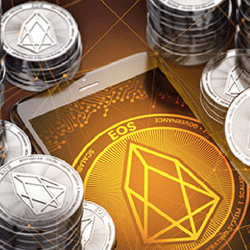The most effective architecture for decentralized applications (as it calls itself), EOS is a blockchain-based, decentralized framework that facilitates the creation, hosting, and execution of commercially-scale, decentralized applications (dApps) on its network.
There is no official full type for EOS, and the developers have chosen not to officially describe it themselves. It supports all of the key features needed to enable companies and individuals to develop blockchain-based applications in a manner comparable to web-based applications, such as offering safe access and authentication, authorization, data hosting, user management, and connectivity between dApps and the Internet.
It is also backed by a mobile toolkit for GUI development, making it a full offering for easy-to-use app development. It essentially operates like the Google Play Store and the Apple App Store.
The meaning of EOS.
Ethernet over Sonnet is a strong blockchain-based architecture that allows the creation, hosting, and execution of decentralized applications. It’s the brainchild of Dan Larimer, who is a co-founder of Bitshares and Steemit.
Like Ethereum, it includes an operating system that simplifies the process of developing Decentralized Applications widely referred to as DApps. However, unlike Ethereum, EOS aims to be more modular and versatile to make it easier for developers to build decentralized applications.
Decentralized systems operate on decentralized and not centralized peer-to-peer network servers. Unlike other applications, they do not require third parties or intermediaries to run. Instead, they link users directly to the providers.

How does it work?
Simply put, EOS is an infrastructure that complements the internet. It serves as software that enables developers to build decentralized apps by using blockchain technology. The EOS network is developed to satisfy the efficiency criteria of decentralized systems when communicating with millions of users at any given time.
Unlike other sites used by DApps, EOS does not have any charge specifications. It is also upgradable and comes with a low latency that enables transactions to be scalable to millions per second.
The network uses Delegated Proof of Stake DPOS as a consensus algorithm to protect the blockchain. Unlike Proof of Work (POW) or Proof of Stake (POS) algorithms, only those carrying blockchain tokens using EOS.IO apps are eligible to vote for block producers. Delegates will only create blocks based on the number of votes they collect from other manufacturers.
In 3 seconds, a single approved producer creates a block in the EOS blockchain. The network rewards block creators with tokens instead of transaction fees for each block generated. The coin depends on individuals and votes to protect the blockchain as opposed to miners solving complicated puzzles.
How is this coin different?
Although there are already a variety of blockchain-based networks such as Ethereum, which enable decentralized applications, EOS focuses on crucial blockchain pain points and aims to solve the problems of latency, scalability, and usability that often become a bottleneck for such blockchain-based frameworks.
As the scale of the dApps community grows with each passing day on a given blockchain network, it also struggles due to the finite supply of resources on the network. This involves concerns such as being restricted by a vast number of fraudulent transactions and related demands, spamming applications, poor speed of execution, and insufficient processing resources available across the network.
EOS.IO aims to address these challenges by providing more scalability, consistency, and accessibility through its specific mechanism.
It claims to be able to accommodate thousands of commercial apps without reaching output bottlenecks by simultaneous execution and asynchronous communication technique across the network. Performance is further improved by removing the different modules involved in the activity of dApps. The authentication method, for example, is executed independently from the execution.
EOS.IO provides consistency in the production and management of dApps across a range of features. Its ownership arrangement encourages unrestricted consumer use and reduces transaction costs as developers are permitted to use services in proportion to their stakes instead of the traditional pay-per-transaction model. This also makes it easier for app developers to anticipate hosting costs and allow them to build successful monetization strategies.
EOS.IO uses delegated proof-of-stake and a role-based permissions concept that enables flexibility to make immediate high-level decisions, such as roll-back, freezing, and bug fixing for broken applications, by majority consensus among established stakeholders.
It comes with key usability features – a web toolkit for interface creation, self-describing frameworks, self-describing database schemas, and a declarative authorization scheme – that make it simple for the developer to build and manage applications.
The relation between EOS and Fiat Currencies.
There is no way to purchase EOS using Fiat currencies. The only thing you can do is visit an exchange like Coinbase to use fiat currencies to buy ETH or BTC. If in control of either BTC or ETH, you can use it to purchase it on either of the top crypto exchanges. Coinbase and CEX.IO are the two exchanges that encourage one to use credit or debit cards to purchase the crypto of choice. If you’ve purchased it, say a BTC or an ETH, you can pass it to another exchange like Binance and use it to buy an EOS.





Crypto for the future